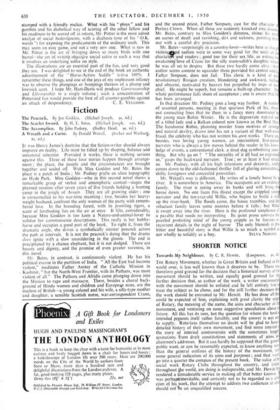Pottership and Lifemen
Lifemanship. By Stephen Potter. Illuitrated by Lt.-Col. Frank Wilson. (Hart-Davis. 6s.) I SUPPOSE the reaction to any kind of wit and humour depends upon a complex personal bias. Most of us are sure that our own sense of humour is immensely perceptive and reliable, but we never feel quite so convinced of its existence in others. What strikes one man as exquisitely. droll may seem to another the dreariest of insipidities. But I cannot imagine that anyone who does not respond with prodigious cackles of delight to Potter on Lifemanship is endowed with even the rudiments of humour. The fun of Mr. Potter has the extraordinary merits of being subtle yet hilarious, concealed and open, allusive and self-evident ; and how delightful it is to find a wit that is neither sick nor soured in this burdened and anxious age !
Of all men, reviewers are the most liable to mendacity, and arc properly looked upon (unless by the very simple-minded) with sus- picion. But it is literally true that I have laughed audibly over every page of this book ; and I shall probably continue to laugh over my favoprite passages, no matter how often I read them. The great success•of Mr. Potter is due not simply to his fun, but in a large degree to his admirable style and his continuous delight in parody. He is a satirist, although a genial satirist, and one who tips you a personal wink in every line, and even his foot-notes are
stamped with a friendly malice. What with his " ploys " and his gambits and his diabolical way of scoring off the other fellow and his readiness to be scored off in return, Mr. Potter is the most adroit analyst of social bedevilments, with a diathesis (one of his " O.K. words ") for exposing the predicaments of the ordinary snob. This may seem an easy game, and not a very new one. What is new in Mr. Potter is the art of bringing down so many birds with one barrel—the art of writing objective social satire in such a way that it involves an underlying satire on style.
The illustrations are an essential part of the fun, and very good ,they are. I was delighted to see at the end of the book an authentic advertisement of the " Horse-Action Saddle " (circa 1895). 1 remember these things, and one of the joys of my unpleasant infancy was to observe the plungings or bumpings thereon of a plump and liversick aunt. I hope Mr. Hart-Davis will produce Gamesmanship and Lifenianship in a single volume ; such a concentration of Potterised fun would provide the best of all counter-gambits against







































 Previous page
Previous page